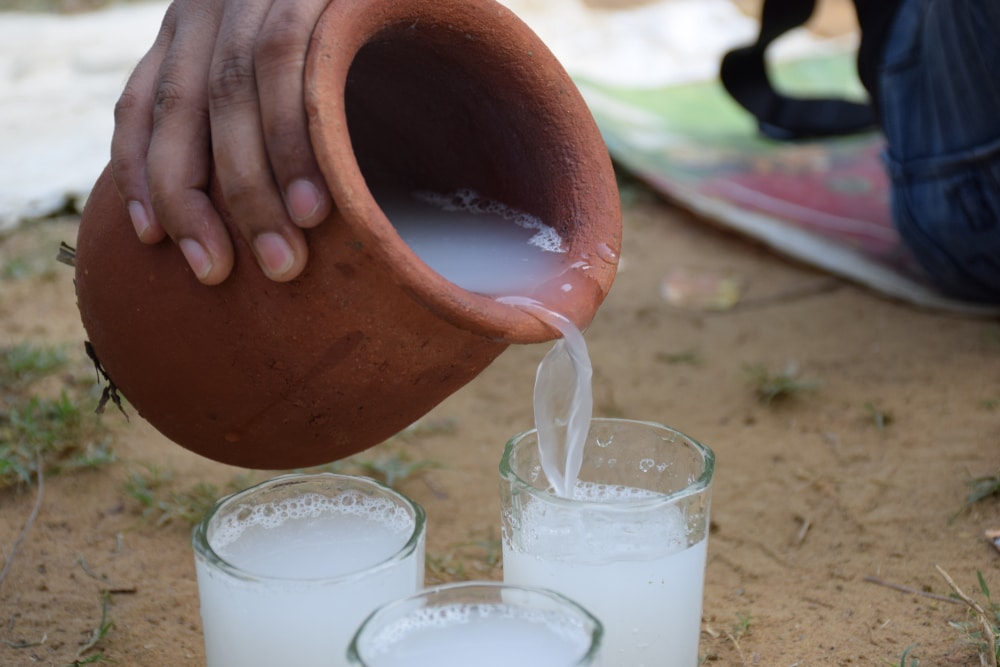Palm wine is a traditional drink often consumed in customary gatherings such as weddings, cultural festivals, burials, and village meetings in Africa. It is an alcoholic drink that is gotten from the tree sap of different species of a palm trees. It is cloudy white and gives off bubbles.
The Igbo people of southeastern Nigeria call Palm wine Nkwu ocha which means white wine or nkwu elu meaning up wine. Hausa people call it Bammi and the Yorubas call it emu. It is also called pami which is a shortened version of palm wine. It is a revered and symbolic drink in many cultures. The Yorubas of Southwestern Nigeria refer to wine tapped from raffia palms as real wine whereas those tapped from the sap of other types of a palm tree are adulterated wine. Among Igbos, wine made from oil palms is more esteemed.
How palm wine tastes
Just imagine a glass of sweetened water with a tinge of sourness. That’s how fresh palm wine tastes. The sourness increases as time passes and if it is stored at room temperature.
Nutritional and health benefits of palm wine
Although palm wine is an alcoholic drink, it has some nutritional benefits when it is freshly tapped with a very low alcohol strength of 1-2 percent. It contains various sugars in the form of glucose, fructose, and sucrose hence high in calories. Palm wine is also a source of vitamins as it contains B vitamins: thiamine(B1), riboflavin (b2), niacin (B3), and pyridoxine (B6), protein, and minute amounts of fat. Palm wine also contains trace elements such as zinc, iron, magnesium, copper, manganese, and potassium.
Palm wine is said to be good for the eye because of the yeast contents. Palm wine improves the ability to see distant objects and reduces the pressure inside the eyes. However, more research is needed to further prove this scientifically.
Palm wine for nursing mothers
Freshly tapped palm wine is said to be beneficial in breast milk flow for nursing mothers. This claim has not been substantiated as there is no scientific evidence to back it up. The mechanism by which palm wine increases the flow of breast milk is not clear but it’s probably because increased fluid intake aids breast milk production. Palm wine gets into breast milk and due to the alcohol content is not safe for a newborn.

Palm wine and pregnancy
We often get asked if palm wine is good for a pregnant lady. Alcohol is associated with bad pregnancy outcomes such as causing low birth weight, preterm, or stillbirth in women who consume alcohol during pregnancy. Consumption of alcohol in pregnancy is associated with behavioural and mental abnormalities in the child. It is therefore recommended that pregnant women abstain from taking any alcoholic beverages through all trimesters of pregnancy.
Palm wine on fertility
Palm wine has been found to cause a decrease in testosterone levels and sperm count. Abstinence is recommended in women who are trying to conceive because of the risk of malformations in the baby even before the woman misses a period.
Harmful effects of palm wine
Consumption of alcoholic beverages in large amounts can be harmful to your liver because it is detoxified in your liver. It can cause liver disease, and nerve and brain problems.
Palmwine can increase your blood sugar and if you have diabetes mellitus, taking palm wine may lead to poor sugar control even though you are judiciously taking your medications.
Palm wine can get you drunk, thereby putting you at risk of abnormal behaviours, injuries from accidents, and even seizures.
In early pregnancy, alcohol can cause miscarriage as it is toxic to the developing foetus.
Palm wine tappers usually mix it with some water before selling it for consumption. Contamination from water used in the dilution of palm wine is almost impossible. Palmwine may also be contaminated by microorganisms in the collection gourd, particularly if not properly washed or from insects in the environment where the tree sap is collected.
Palm wine is harmful whether it is taken alone or diluted with other drinks, herbs, or traditional medications.
Alcohol Strength of palm wine
Palm wine freshly tapped has little alcohol but as it begins to ferment, its alcohol strength increases. Fermented palm wine has an alcohol strength of at least 3 percent. This means that 100mls of the drink contains 3 grams of alcohol. This fermentation process begins immediately when it is tapped and may be reduced by storage at very low temperatures. Microorganisms play a role in the fermentation process which accounts for the sour taste of the drink. The longer it stays at room temperature or under sunlight, the more alcohol strength. The fermentation process is sped up when it is tightly covered at room temperatures.
That is why palm wine taken in the morning freshly tapped is sweeter than one taken in the evening which is sourer with higher alcohol strength.
Alcohol in palm wine ranges from 1.5 to 2.1 percent when freshly tapped to as high as 5 percent in 24 hours and even more after 24 hours.
Microorganisms (fungi) called yeasts convert sugar to alcohol and give palm wine the characteristic aroma. Other organisms – lactic acid bacteria (LAB) and acetic acid bacteria convert alcohol to vinegar if it is allowed to continue to ferment for over 24 hours. This is more acidic and is not palatable for most people.
Palm wine can be further processed (distillation) to get a highly concentrated alcoholic drink called Kai Kai or ogogoro which has an alcohol strength of up to 40 percent.
Storage of palm wine
Palm wine often collected in gourds is dispensed for consumption in calabash or cups. It is stored in calabash or gallons and covered with palm fronts inserted into the mouth of the bottle. If the bottle is to be covered, the gallon cover is perforated in the middle to slow down the fermentation process.
How palm wine is tapped
Palm wine tappers work with a special type of strong rope made from the trunk and stem of the palm tree, called agbu. They would go to the palm tree in the morning to collect the tree sap. At the same time, they put the collection gourds or calabash tied with a rope around the tree after making cuts on the top of the tree trunk using a sharp knife.
The tree sap is collected all through the day and the palm wine tapper comes back in the morning for it. The palm wine tappers climb tall palm trees with the aid of the firm round rope as support. They put the rope around their lower back, encircle it around themselves and the tree and then tie both ends tightly. They then move the rope up as they climb. When they get to the top, the rope provides support while they retrieve the calabash(es) with the palm wine.
You can get palm wine from rural markets, bush bars, restaurants, and recreational centers.
Palm wine is a natural drink that is best taken freshly tapped. It should be taken in moderation because of the harmful effects of the alcohol in it. Pregnant women and nursing mothers should avoid alcohol as it is unsafe for their growing babies.




